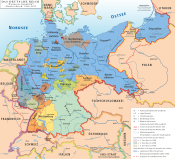| Free State of Waldeck-Pyrmont (1918–21) Freistaat Waldeck-Pyrmont Free State of Waldeck (1921–29) Freistaat Waldeck | |||||||||||||
|---|---|---|---|---|---|---|---|---|---|---|---|---|---|
| State of the Weimar Republic | |||||||||||||
| 1918–1929 | |||||||||||||
|
Flag | |||||||||||||
 The Free State of Waldeck-Pyrmont (red) within the Weimar Republic (after 1921) | |||||||||||||
| Anthem | |||||||||||||
| Das Waldecker Lied | |||||||||||||
| Capital | Arolsen | ||||||||||||
| Population | |||||||||||||
• 1925 | 55,750 | ||||||||||||
| • Type | Republic | ||||||||||||
| Historical era | Interwar period | ||||||||||||
| 1918 | |||||||||||||
| 1921 | |||||||||||||
• Merges with Prussian province of Hesse-Nassau | 1929 | ||||||||||||
| |||||||||||||
The Free State of Waldeck-Pyrmont (German: Freistaat Waldeck-Pyrmont), later the Free State of Waldeck (Freistaat Waldeck), was a constituent state of the Weimar Republic. It was created following the German Revolution which forced Prince Friedrich of Waldeck and Pyrmont along with the other German monarchs to abdicate.
On 30 November 1921, following a local plebiscite, the city and district of Pyrmont were detached and incorporated into the Prussian province of Hanover. The remainder of the State was incorporated into the Free State of Prussia on 1 May 1929, following another plebiscite, and became part of the province of Hesse-Nassau. The territory is today part of the District of Waldeck-Frankenberg in Hesse.
State directors (1918–1929)[edit]
- 1918–1920 Karl von Redern
- 1920–1929 Wilhelm Schmieding (DVP)
- 1929–1929 Herbert Herberg
External links[edit]
- (in German) Waldeck Free State
- States of Germany since 1918


Well, that’s interesting to know that Psilotum nudum are known as whisk ferns. Psilotum nudum is the commoner species of the two. While the P. flaccidum is a rare species and is found in the tropical islands. Both the species are usually epiphytic in habit and grow upon tree ferns. These species may also be terrestrial and grow in humus or in the crevices of the rocks.
View the detailed Guide of Psilotum nudum: Detailed Study Of Psilotum Nudum (Whisk Fern), Classification, Anatomy, Reproduction